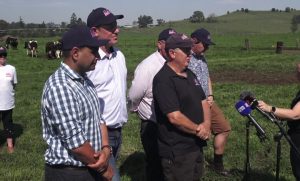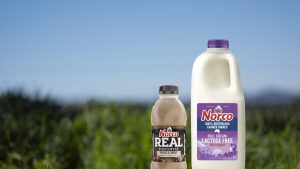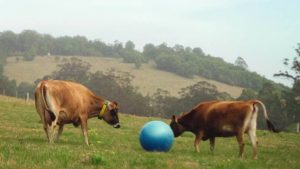
Key points:
- It could be months before Norco can reopen its ice-cream factory in Lismore
- Flooding has affected half of the co-operative’s 200 dairy farms in NSW and Queensland
- Norco suppliers have been paid for 200,000 litres of milk dumped during the floods
WARNING: This article contains images that people may find distressing
Livestock, fences and pastures have been lost, machinery, homes and dairies destroyed and 200,000 litres of milk dumped so far.
Norco’s ice-cream factory, head office and rural store in South Lismore were inundated with floodwater from the swollen Wilsons River.
Chief executive Michael Hampson said the water reached 2.2 metres at the ice-cream factory and 1.9 metres at the head office.
“I think it was only on the Sunday when we had some people that were stationed at the ice-cream facility and they were fighting an adversary that they just couldn’t win against,” he said.
‘We knew then that we were dealing with not just a flood here, we were dealing with significant devastation.”
Mr Hampson said he expected the flood damage would see the ice-cream plant out of commission for a “fair amount” of time.
“The stock’s all gone but we have other cold storages in Brisbane and Sydney that has unaffected stock that we’re dispatching to customers,” he said.
“There’s certainly a significant clean-up job that needs to be undertaken there over the coming days and weeks, and then there will be the assessment of how the equipment performs once it’s livened up with power.”
Rocky road ahead for dairy
Dairy farmers are among the flood-affected primary producers in NSW now eligible for grants of up to $75,000, freight subsidies up to 50 per cent and low-interest loans of up to $130,000.
Norco is also paying for any milk dumped, organising fodder and food drops, and is offering no-interest loans for items such as fencing bought through its rural stores.
Mr Hampson said half of its 200 farms in NSW and Queensland had been affected.
“We’ve got dairy farmers from north of Gympie and down into the Oxley Island and Taree in the south, but in the Lismore area most of the dairy farmers are going to have bills of $1 million, $2 million, some $3 million to rebuild — they’re big numbers.”
“These are family businesses, but the price of rebuilding dairies and getting herds is not what it was five or 10 years ago; there’s been huge amounts of inflation, so our dairy farmers are going to need a lot of financial help to rebuild.
“In this area we’ve got five farms that are significantly affected and we’ve been trying to help organise helicopter drops of food and fodder into their facilities to help them and their livestock during this time.”
He said he was on the phone with a dairy farmer during the flood when his cattle were being washed away.
“Farmers are very resilient, they can seem to put these sort of things behind them, but I think this time they really need some additional help.
“Certainly for some of our farms, this might be the second time in a few years where they’ve been through devastation.
“Let’s not forget whilst we’re talking about a flood, it wasn’t too long ago some of these farms took on hundreds of thousands of dollars worth of debt in the drought to feed cattle, so the industry at the moment does need significant assistance.”
























